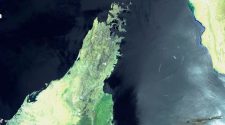Cory Brocklehurst, Innovation and Technology Director for the Newfoundland and Labrador Construction Association, says geogrid technology is paving the way to better, longer-lasting roads in Newfoundland and Labrador. He says this innovative technology allows owners, engineers and contractors to optimize the thickness of pavement components, extend pavement service life and stabilize soft ground conditions — all while simultaneously saving taxpayer money.
Brocklehurst is the Territory Manager for Arrow Construction Products Limited and the Director of Innovation and Technology for the Newfoundland and Labrador Construction Association.
Brocklehurst says the technology’s polyethylene grid gives aggregate — the rock fill used in the roads — lateral constraint which holds it together. He says this is due to one of the technology’s key features — its ability to stress transfer or distribute the weight of vehicles like a snowshoe displaces snow.
“For pavement optimization, sub base stabilization and cost-benefit analysis, there is nothing I’ve seen proven more effective than this,” says Brocklehurst.
A cost-saving solution
The geogrid’s design works to optimize pavement thickness components, extend pavement life and stabilize soft ground conditions.
“It’s a simple technology — a piece of plastic. But it’s more about the evolution of the product being used in road development,” he says.
Brocklehurst says since pavement failure is often due to ongoing displacement of materials supporting the road, installing geogrid to confine the aggregate, distribute the load and improve overall road stiffness also reduces upfront and future maintenance costs.
There is an upfront cost that comes with using geogrid in a project, but Brocklehurst says this is part of what saves future maintenance costs as the technology prolongs the road’s lifespan and all but eliminates regular infrastructure repairs — routine maintenance typically scheduled every four to five years happens after two decades instead, according to Brocklehurst.
And this is why he says it has been used in projects across Atlantic Canada and around the world.
“A road designed for 22,000 equivalent single axle loads or ESAL’s, extends to 123,000,” says Brocklehurst.
“You are investing more, but it is minimal when compared to what you save in repairs. This technology is making roads to last.”
Impact on future NL roads
Brocklehurst says geogrid has the potential to impact much of the province as it saves costs and prolongs the life of its roads and is implemented in a growing number of projects.
With freeze-thaw cycles, Brocklehurst says the province’s stand to benefit even more from the technology as it also keeps the roads from resulting upheaval.
“The geogrid confines the aggregate and prevents the extreme temperatures from damaging roads as they typically do,” says Brocklehurst.
The province is also mostly made up of either rocky or boggy land, both of which make road construction all the more difficult — during the construction phase when heavy machinery needs to drive through the jobsite and during the creation of the road surface.
Brocklehurst says a geogrid used on soft soil or boggy terrain enables big machinery to travel where they need to go and later retains the roads’ subbase to provide a strong foundation to build upon.
He says the technology can also be used in building cheaper roads over shallow surfaces including rocky land or over underground infrastructure.
“A lot of roads are built where going down deep is hard because of rock or existing infrastructure. [With this technology] you can build a thin road with a layer of grid and get the same performance of a normal road without the additional depth,” says Brocklehurst.
So whether used as a more cost-effective solution, to extend road lifespan or to build in tricky terrain, Brocklehurst says the system is a top option for roadways of all types and sizes.
“If we can make roads last five times longer, it’s something all government entities should consider,” he says.
For more information on new products and technologies, be sure to participate in the free Construction Corner sessions at our Centre of Excellence. Visit NLCA.ca for more details.

















